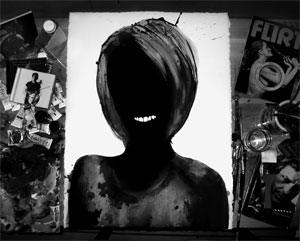The art world mullahs have been saying it for a long time, even needy novelist Jonathan Franzen has piped in – the twentieth century: the century of collage. Commentators forget that the chaos, discontinuity, intertextuality, and morphological mechanics of collage have had their equivalent in figural art since the end of the First World War. We need only think of punk anachronisms such as Otto Dix’s or Philip Guston’s; artists who were both clearly well acquainted with the people around them as well as the substances said locals tended to use in order to most efficiently obliterate themselves and their surroundings.
In Wyatt’s tormented paintings, which emerge through practices that incorporate morphogenesis, superimposition, redirection, plurality, repetition, and radical aperture, we witness something that hints at a connection to this tradition. The key elements are the body and the nature of light and orifice (openings and luminosity being where aperture comes in). Everything in Wyatt’s cabalistic portraiture is gauged for sensory-motor impact at the bio-physical level, registered and measured on Antonin Artaud’s “nerve meter,” frozen in time as it spills from the body like the consciousness of Ellison’s invisible narrator as he undergoes shock therapy (much like one of Wyatt’s subjects did – the bipolar, psychedelic wunderkind Rocky Erickson, after being busted for grass in Austin and pleading insanity) … or like the solar ray that comes out of Judge Schreber’s asshole whenever he starts to cogitate in Freud’s famous case study.
Wyatt shares Bacon’s and Baselitz’s seemingly Gnostic ability to perceive unseen partial autonomies of the flesh, giving still human figures the illusion of alien activities (which are no illusion). His paintings strive towards a release from this flesh: the body emerges from its translucid onion skin and the plasmid that is left behind is rendered temporarily visible while it decays; his most extraordinary works are unarmed attempts to extend the half-life of this after-image. Of course, a collage might manage such a task, but one then risks losing the opportunity to witness that all-consuming Orgone glow in its natural habitat.
Jason Wierzba
Painting is a deliriant. After late nights in the studio I collapse into violent, dissociative dreams. In the morning - the taste of blood in my mouth from the hunters I've killed and an uneasy feeling that I'm more animal than human.
This recent work might be read as a codex of paranormal activities...
Consciousness radiating in all directions - like a SETI transmission. But Not One of Ours.
I'm constantly shedding any accumulation of technique, aesthetics and dogma that might interfere with my reception of the mysterious, resonating currents that flow through the air and conveniently take possession of my hand whenever I try to paint (picture arcing Tesla coils, the hand of Frankenstein grasping for a paintbrush, etc.) These currents seem to materialize only where accidents and directness are allowed to exist. By 'directness' I mean: not having any separation between thought and hand. The best way to shorten the distance between these two points? Eliminate thought completely. My method of painting is closer to Visitation, Vodun trance, Psychokinesis and Fishing than any other definable techniques that are accomplished with paint and brush.
I try to look at the subject as though human eyes have never encountered it before...then I start to paint. I often fail miserably... but my intentions are pure.
"Art is what they call it afterwards, you know." [Philip Guston]
"Space is the Place." [Sun Ra]
Wyatt
-
Thursday, May 31, 2007 to Saturday, June 30, 2007
Opening- Thursday, May 31, 2007
